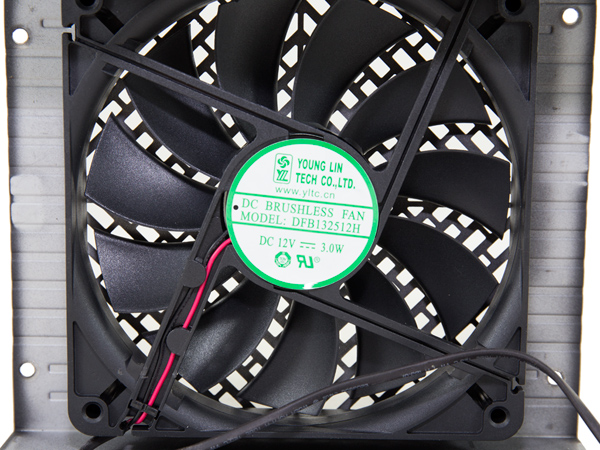Rosewill Capstone-G1200 PSU Review
Why you can trust Tom's Hardware
A Look Inside And Component Analysis
Parts Description
Before proceeding with this page, we strongly encourage you to a look at this article, which provides valuable information about PSUs and their operation, allowing you to better understand the components we're about to discuss. Our main tools for disassembling PSUs are a Thermaltronics soldering and rework station, and a Hakko 808 desoldering gun.
| Primary Side | |
|---|---|
| Transient Filter | 4x Y caps, 5x X caps, 2x CM chokes, 1x MOV, 1x CM02X |
| Inrush Protection | NTC thermistor and diode |
| Bridge Rectifier(s) | 2x GBU1506 (600V, 15A @ 100 °C) |
| APFC MOSFETs | 2x Infineon SPW60R099C6 (650V, 24A @ 100 °C, 0.099 ohm) |
| APFC Boost Diode | 1x STTH3006DPI (600V, 30A @ 150 °C) |
| Hold-up Cap(s) | 2x Nippon Chemi-Con (450V, 390uF each or 780uF combined, 2000h @ 105 °C, KMR) |
| Main Switchers | 2x Infineon SPW60R099C6 (650V, 24A @ 100 °C, 0.099 ohm) |
| Reset Switch | Fairchild FQPF3N80C (800V, 1.9A @ 100 °C, 4.8 ohm) |
| APFC Controller | Champion CM6802 |
| Switching Controller | Texas Instruments UC2715D |
| Topology | Primary side: Double Transistor Active Clamp Reset Forward (ACRF) Secondary side: Synchronous Rectification & DC-DC converters |
| Secondary Side | |
| +12V MOSFETs | 4x Infineon IPP023N04N G (40V, 90A @ 100 °C, 2.3 mohm) |
| 5V & 3.3V | DC-DC Converters PWM Controller: 2x ANPEC APW7073 |
| Filtering Capacitors | Electrolytics: Unicon (Gemmy), Dura Tech, 5x Chemi-Con (105 °C), 1x Rubycon (-12V) Polymers: Enesol (DC-DC converters), Dura Tech (Modular PCB) |
| Supervisor IC | SITI PS223 (OVP, UVP, OCP, SCP, OTP ) |
| Fan Model | Young Lin Tech double ball-bearing fan DFB132512H (135mm, 12V, 3W, 2500 RPM) |
| 5VSB Circuit | |
| Rectifier | 1x PFR10V45CT |
| Standby PWM Controller | Sanken STR-A6062H (23W @ 230VAC, 18W @ Universal) |
This PSU uses an Active Clamp Reset Forward (ACRF) topology in the primary side and the usual stuff on the secondary side: a synchronous design for regulating the +12V rail and DC-DC converters for the minor rails. Its heat sinks are huge, similar to every high-capacity Enhance PSU we've seen. Admittedly, the company's capacitor selection is a little strange, since we found a couple of brands that we don't encounter often in this price range. Not that we have anything against Unicon or Dura Tech caps. However, we don't have any solid information about their reliability under tough conditions. We'd prefer to see Chemi-Con or Rubycon caps instead.
The ACRF topology provides high efficiency at lower cost since there's no need for an LLC resonant converter or FETs with very low RDS-on values. In this case, we have a two power switch ACRF design, where a couple of FETs act as the main switchers (Q1 and Q2), while a third serves as the reset switch (Q3). The reset switch's job is to disconnect the APFC converter's bulk capacitors while Q1 and Q2 are active. When Q3 is open, power is transferred from the primary to the secondary side. This design allows for almost lossless switching of the Q1 and Q2 FETs, as their drain voltage is very low while both are turned off. A couple of Infineon SPW60R099C6 FETs act as the Q1 and Q2 switches, and a Fairchild FQPF3N80C is the Q3 reset switch.
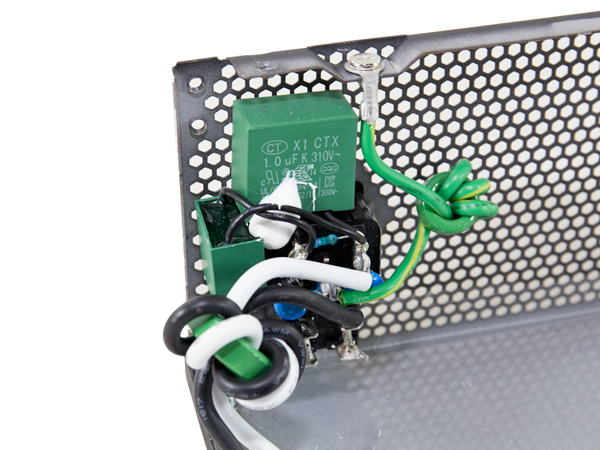


The first part of the EMI filter is right behind the AC receptacle and includes two X caps and two Y ones. It continues on the main PCB with three more X caps, a couple of Ys, two CM chokes and an MOV. Overall, the EMI filter of this PSU is more than complete.
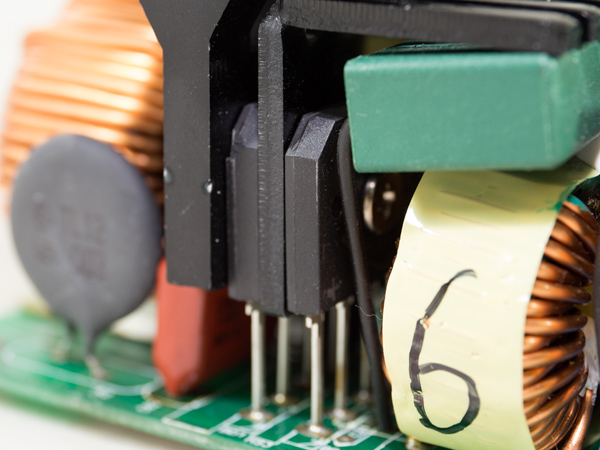

The bridge rectifiers are a pair of GBU1506, which receive cooling from the APFC heat sink and a smaller one.



We spotted a large NTC thermistor before the PFC coil and another smaller one after it. The small NTC thermistor isn't supported by an electromagnetic relay, resulting in quicker cooling and lower energy loss. Instead, it employs a diode. On the other hand, the large thermistor doesn't use anything that would allow it to cool quickly. There's no need anyway, since this thermistor is bypassed. On the solder side of the PCB, we noticed a copper wire that shorts the thermistor's leads, rendering it useless. Enhance could have removed it altogether to save a few cents. More than likely, the PSU couldn't hit 80 PLUS Gold efficiency levels with this thermistor in place, so it was bypassed.
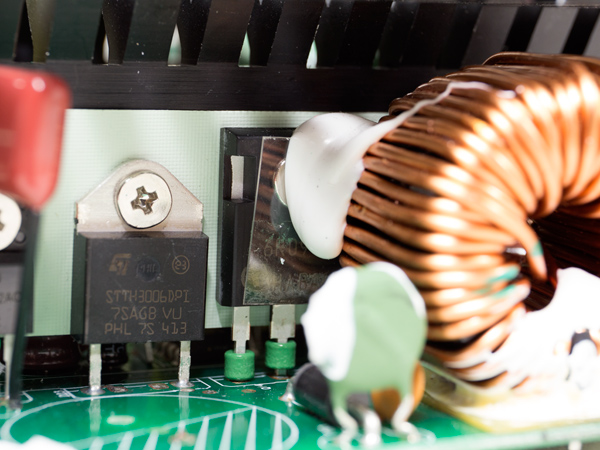

There are two Infineon SPW60R099C6 FETs in the APFC converter, along with a single STTH3006DPI boost diode. The bulk caps are provided by Chemi-Con, rated at 450V and 105 °C, and their combined capacity is 780uF, which is quite low for a 1.2kW PSU.
Get Tom's Hardware's best news and in-depth reviews, straight to your inbox.
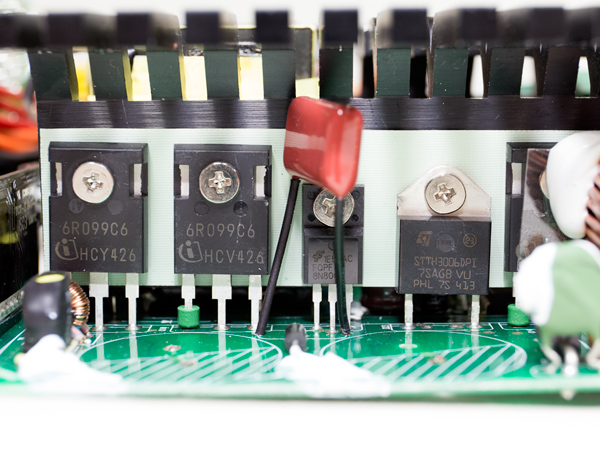



The main switchers are a couple of Infineon SPW60R099C6 FETs. The reset switch is a Fairchild FQPF3N80C. A large vertical daughterboard hosts the PFC controller (a Champion CM6802 IC), and the ACRF controller is a Texas Instruments UC2715D. On the left side of the same daughterboard, we found the supervisor IC, a SITI PS223 capable of supporting all basic protection features. Finally, in the middle of the board are two optocouplers, which offer isolated communication between the primary and secondary sides.


The FETs that regulate the +12V rail are four Infineon IPP023N04N G.
Two thermistors are attached to the large secondary side's heat sink. The first provides information to the fan control circuit, determining fan speed according to the sink's temperature, while the second thermistor sends information to the supervisor IC.



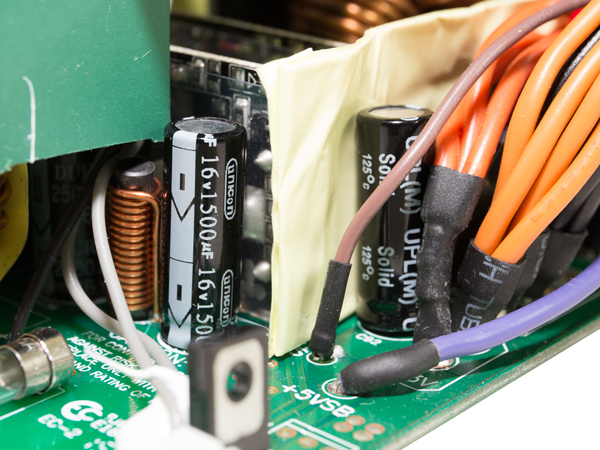

Two small VRMs generate the minor rails. On them, we found polymer caps from Enesol, a respected Korean manufacturer. The other filtering caps on the secondary side come from Chemi-Con, Dura Tech and Unicon. We also found a single Rubycon electrolytic cap. It seems as though Enhance used what it found available and didn't focus on only one brand.


The 5VSB rail is rectified by a PFR10V45CT SBR, while the standby PWM controller is a Sanken STR-A6062H.




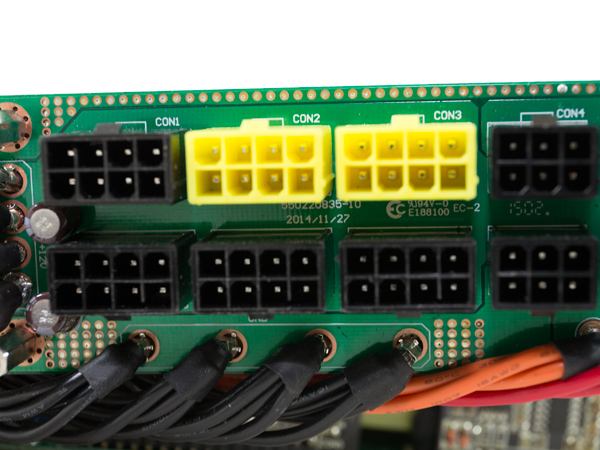

At the front side of the modular PCB, some electrolytic Chemi-Con caps and several Dura Tech polymer ones further suppress ripple. On the bottom of the board, Enhance's soldering quality looks good.









Enhance generally demonstrates good manufacturing quality, and this PCB is a good example. On the solder side and under the transient filter area, we found a CM02X IC that blocks current through an X cap's discharge resistor when AC voltage is connected. This way, less energy is wasted, boosting efficiency.
The cooling fan comes from Young Lin Tech, and its model number is DFB132512H (135mm, 12V, 3W, 1800 RPM, 95 CFM, 38 dB[A]). It uses double ball-bearings, so it should last longer than sleeve-bearing fans (though it's not as reliable as pricier FDB- or HDB-based coolers).
Current page: A Look Inside And Component Analysis
Prev Page Packaging, Contents, Exterior And Cabling Next Page Load Regulation, Hold-Up Time And Inrush Current
Aris Mpitziopoulos is a contributing editor at Tom's Hardware, covering PSUs.
-
Giannis Karagiannis Quite low price for a 1200W unit but considering everything else I dont think its a good buy. Try better next time Rosewill...Reply -
Dark Lord of Tech Rosewill does have some Capstones that are great quality , The Super Flower models.Reply -
Dark Lord of Tech Also Enhance released a lot of nice V and VS series models for Cooler Master.Reply -
Aris_Mp Those older Capstones are EOL because they were older platforms which most likely aren't produced any more and on top of that Super Flower lately cannot meet demand, as the rumors say.Reply -
Dark Lord of Tech Super Flower is still pushing out a lot of units , I own 5 of he EVGA Super Flowers.Reply
The olser Capstones are solid , they are EOL , but were very good. -
DSzymborski Really disappointing to see Rosewill slide back - those older Capstones made by Super Flower were really quite nice and you could frequently get excellent deals on them and I made a couple of builds for people with the semi-modular gold 750s. Too bad.Reply -
MasterMace It's too bad, the previous Capstones were so nice. This makes me wonder if they should have slapped a lower rating on this unit, instead of overshooting for a Gold 1200Reply -
firefoxx04 I wish manufacturers didn't bother making crap power supplies for enthusiasts markets. The fact that they even sell is a huge problem.Reply -
Slobodan-888 LOL, ripple is fine. It is within ATX specifications which states that is is allowed up to 120 mVpp RMS on 12 V rail.Reply


